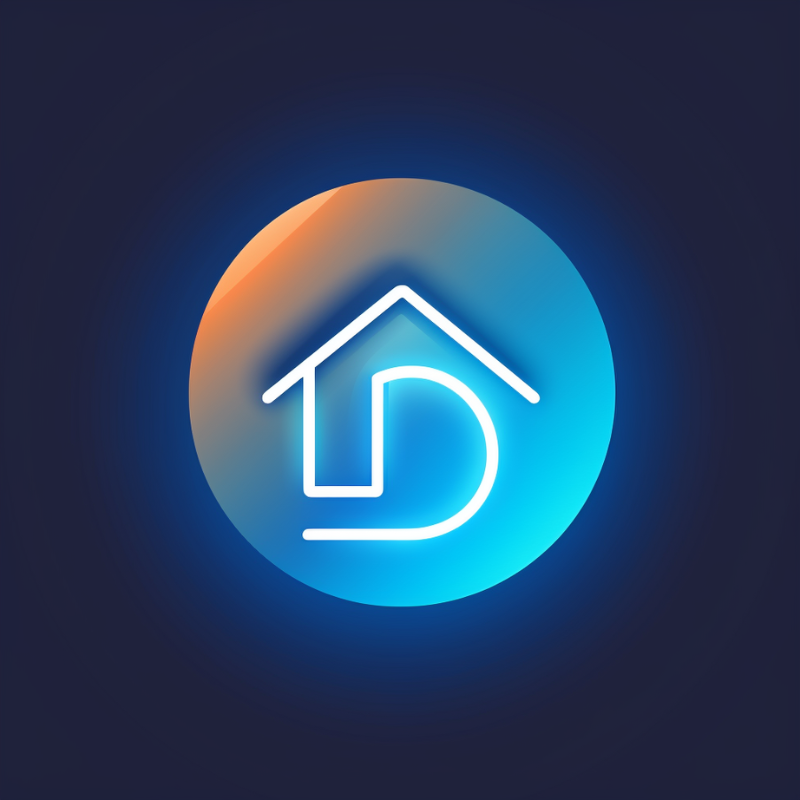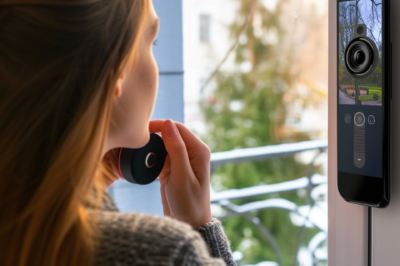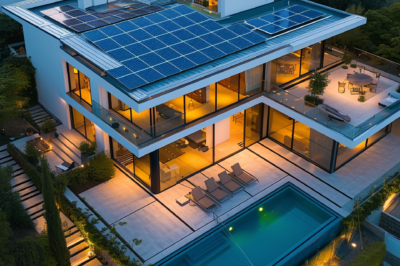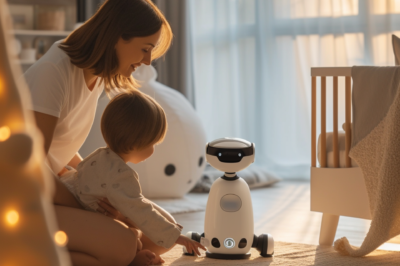Smart home technology has progressed dramatically by 2024, transforming houses into increasingly interconnected and intelligent environments. The emphasis on seamless integration has rendered previously standalone devices and appliances into components of a cohesive ecosystem. With smart home technology now deeply embedded in daily life, homeowners are experiencing unprecedented levels of convenience, security, and energy efficiency.

The advancements in voice assistants and AI interactions have been at the heart of the smart home evolution. These technologies serve as the cornerstone for controlling smart home ecosystems, offering users the ability to manage their homes with simple voice commands. The integration of smart technology extends beyond the home, merging with IoT devices and even vehicles, which allows for a comprehensive and interconnected experience.
Key Takeaways
- Smart homes integrate devices for improved convenience and efficiency.
- Voice assistants and AI underpin the operation of smart home ecosystems.
- Smart technology extends its reach beyond home to IoT and vehicles.
Evolution of Smart Home Technology
The smart home technology landscape is swiftly advancing, marked by the integration of artificial intelligence and the unveiling of cutting-edge gadgets at events like CES. This constant progress is refining daily life and enhancing the functionality of home automation systems.
From Automation to AI
Initially, smart home technology primarily focused on automation—simplifying tasks by programming devices to perform them automatically. Today, AI infuses these systems with the ability to learn from user interactions, making smart homes more adaptive and responsive. For example, smart thermostats and air conditioners utilize AI to optimize energy use while maintaining comfort, exemplifying this shift from simple automation to complex, intelligent systems.
The Emerging Role of CES in Smart Home Innovations
CES has become a pivotal platform for showcasing the latest in smart home technology. At CES 2024, groundbreaking innovations were highlighted, including devices that push the boundaries of home security with facial and palm recognition technologies. The event not only reveals the newest gadgets but also sets the tone for the industry’s direction in the coming years.
The Growth of Smart Home Devices
- Lighting and Plugs: Advances in smart lighting and plugs allow for more energy-efficient and adaptable home environments.
- Climate and Energy: Devices like the aforementioned smart thermostats are becoming more prevalent in homes.
- Home Security: There is a significant presence of smart home security cameras, with 25% of U.S. householders owning one.
- Appliances: Smart appliances continue to integrate into domestic life, with connectivity and remote management being key features.
The expansion of smart home devices evidences a trend towards an interconnected, intelligent living space that is more convenient, secure, and energy-efficient.
Key Smart Home Ecosystems and Platforms

In 2024, smart home ecosystems have become more interconnected and user-friendly thanks to advancements in communication protocols and increased collaboration among industry giants. Homeowners can now enjoy seamless integration between devices, resulting in unprecedented levels of automation and convenience.
Matter and IFTTT Integration
Matter, the industry-unifying standard, has emerged as the cornerstone of smart home interoperability. This protocol allows for secure, reliable communication across different devices and ecosystems. Notably, IFTTT (If This Then That) integration complements Matter by enabling customizable automation. Users can create “Applets” that trigger actions between devices that wouldn’t typically communicate with one another, bridging the gap between different platforms and manufacturers.
Major Players: Google, Amazon, and Apple
- Amazon Alexa, Google Assistant, and Apple’s Siri dominate as key players in the smart home sector. Each platform supports Matter, ensuring their continued relevance and adaptability in the smart home landscape. Amazon Alexa leads with a vast selection of compatible devices and intuitive voice control.
- Google Assistant excels with its AI capabilities, offering a more conversational and personalized experience. It emphasizes integration with Google’s suite of services.
- Apple focuses on privacy and user experience, with Siri being a central part of the seamless ecosystem that includes iPhones, iPads, and HomePods. Apple’s commitment to security appeals to privacy-conscious consumers.
Each platform allows users to control their smart ecosystem through voice commands and supports a growing range of compatible devices.
Samsung SmartThings and Other Proprietary Systems
Samsung’s SmartThings ecosystem represents a significant player in the proprietary systems domain. Its intuitive user interface and wide-ranging device compatibility make it a strong competitor. SmartThings not only supports Matter but also retains unique features catering to Samsung device users, offering a more integrated experience for those within the Samsung environment.
Other proprietary systems are also in play, offering niche functionalities and catering to specific user needs. These systems often maintain a strong brand loyalty by providing unique features that are optimized for their specific hardware and services.
Revolutionizing Daily Life: Smart Rooms and Functions
The home of 2024 embraces innovative technology designed for enhancing convenience and efficiency in every room. Here’s how homes are getting smarter and life more streamlined, room by room.
Living Room Innovations and Entertainment
The living room has become the centerpiece of smart home technology with a focus on entertainment and relaxation. Voice-controlled systems can now manage multimedia content, lighting, and climate, creating a tailored ambiance at a moment’s notice. Furniture with embedded sensors adjusts to individual preferences for comfort and support. Moreover, high-resolution projectors and smart windows transform spaces into immersive environments, allowing for a cinematic experience from the comfort of one’s couch.
Smart Kitchens and Appliances
In smart kitchens, efficiency and convenience have reached new heights. Appliances equipped with AI algorithms learn from user preferences to enhance the cooking experience. For instance, refrigerators suggest recipes based on their contents, minimizing food waste. Smart ovens preheat to the exact temperature for the recipe selected, and can even suggest meal plans and cooking tips, which is a testament to the advancements in smart kitchen appliances.
| Smart Kitchen Features | Benefits |
|---|---|
| AI Refrigerators | Tailored recipe suggestions, inventory management |
| Automated Dishwashers | Water and energy-efficient cleaning |
| Smart Ovens | Precision cooking, remote control |
Bedrooms and Personal Comfort
Smart bedrooms prioritize personal comfort and well-being. Mattresses have evolved to track sleep patterns and adjust firmness real-time for optimal rest. Closet systems assist in outfit selection, while smart mirrors provide health and fitness feedback. Lights and sound systems work together to simulate natural environments, supporting a consistent sleep-wake cycle. This degree of personalization underscores how technology in the bedroom is not just a luxury, but a driver for better health.
Enhancing Home Security and Safety
In 2024, smart home technology continues to prioritize the safety of residents. Technological advancements in security devices and systems offer improved protection through heightened detection, identification, and response capabilities.
Advanced Smart Locks and Access Controls
Smart locks have significantly evolved, now providing homeowners with robust access control systems capable of facial recognition and advanced biometrics. These systems enable fine-grained control over who can access a property, and they keep a detailed log of entries and exits. For instance, sophisticated smart locks allow for temporary access codes for guests, which can be managed remotely via smartphones.
- Facial Recognition: Intelligent systems confirm identities with precision.
- Biometrics: Enhances security by requiring unique biological traits for entry.
Next-Gen Surveillance and Monitoring
Surveillance technology in 2024 harnesses the power of AI and machine learning to offer next-generation cameras and smart doorbells. These systems not only capture high-definition video but also analyze footage to distinguish between ordinary activity and potential security threats. This means fewer false alarms and quicker response times to actual dangers.
- High-Definition Video: Provides clear and detailed images for better monitoring.
- Threat Analysis: AI algorithms detect and alert homeowners to unusual activities.
Intelligent Alarm Systems and Safety Detectors
Gone are the days of simple burglar alarms. Today’s intelligent alarm systems are multifaceted, providing detection for a wide array of safety concerns including break-ins, fire, gas leaks, and more. They communicate with the homeowner’s mobile devices and, in some cases, directly with emergency services for immediate response.
- Multi-Detection: Sensitive to a variety of safety issues, from intrusion to environmental dangers.
- Direct Communication: Instantly connects with homeowners and authorities during alarms.
2024 stands as a hallmark year for home security, where safety is enhanced through smart technology integration.
Voice Assistants and AI Interactions
Voice assistants have shifted from being a novel feature to a central element in smart home ecosystems. They serve as the linchpin in the orchestration of device interconnectivity and user experience enhancement, largely thanks to advancements in AI.
The Role of Voice in Smart Home Control
Voice assistants have become integral to controlling smart home devices, offering a hands-free and intuitive method for managing an array of gadgets. With Amazon Alexa, Google Assistant, and Siri leading the charge, these AI-driven companions process natural language commands to perform tasks such as adjusting thermostats, dimming lights, or streaming media. The evolution of devices like the Amazon Echo and Apple’s HomePod reflect a broader trend towards ambient computing, where user convenience and seamless interaction are paramount.
Cross-Compatibility and Voice Assistant Wars
As voice assistants evolve, the battle over cross-compatibility becomes crucial for a cohesive smart home experience. Users typically seek an ecosystem where “Hey Google,” “Alexa,” or “Hey Siri” can interface with the widest range of devices. Manufacturers and developers are increasingly aware of this demand. Google Assistant aims to support a multitude of devices, while Amazon has been proactive in creating open-source frameworks to broaden Alexa compatibility. They strive to ensure their platforms remain accessible across various brands and smart home technologies to secure a dominant position in the market.
Energy Management and Sustainability
In the realm of smart home technology, energy management and sustainability have become prominent focal points. Emphasizing energy efficiency and eco-friendly practices, these innovations are reshaping how households consume energy.
Smart Thermostats and Climate Control
Smart thermostats have revolutionized climate control within the modern home. These devices enable precise temperature regulation and adapt to user habits, leading to significant energy savings. Products like the Nest Thermostat learn preferences and adjust accordingly, while also providing homeowners with detailed energy usage reports.
Energy-Efficient Appliances and Monitoring
Energy-efficient appliances have also made notable strides. With smart appliance integrations, they not only perform their tasks with reduced energy consumption but also report on energy use. For instance, refrigerators can now monitor their power usage and suggest optimal operation times to sync with lower utility rates.
Eco-Friendly Smart Home Trends
Trends in eco-friendly smart home technology are driven by a commitment to sustainability. This includes not only the devices themselves but the materials and methods used in their production. Solar-enabled devices and other renewable energy sources are becoming integrated into smart home ecosystems, reinforcing the push towards a greener future.
The Intersection of Smart Homes with IoT and Cars
The synergy between smart homes, the Internet of Things (IoT), and smart cars is transforming how we interact with technology. This fusion is leading to unprecedented levels of automation and connectivity.
Home Automation and IoT Devices
Smart homes have become the standard, with IoT devices at the core of this revolution. These devices range from smart thermostats that adjust temperature based on user patterns to sophisticated security systems that can be monitored and controlled remotely. The common thread is connectivity, enabling these devices to communicate with one another. For example, residents can have their smart lights turn on automatically when their smart locks are activated, signaling their arrival home.
- IoT Devices Commonly Used in Smart Homes:
- Smart Thermostats
- Intelligent Security Cameras
- Automated Lighting
- Voice-Activated Assistants
These devices are not standalone units but part of a vast interconnected network, often managed and monitored via a central hub or a smartphone app. The IoT is the backbone that allows these devices to work in concert, creating a seamlessly automated environment.
Integrating Smart Homes with Smart Cars
The integration between smart homes and smart cars is a noteworthy development, representing the next step in automotive and home automation technology. Smart vehicles can communicate with home IoT ecosystems, performing tasks such as preheating the house or opening the garage door as the car approaches. Advanced telematics and IoT platforms have made this a reality, with some systems even capable of notifying a homeowner if they’ve left the lights on after they’ve driven away.
- Examples of Car and Home Automation Integration:
- Geo-fencing: Upon entering a predefined vicinity of the home, the car can send a signal to the smart home system to adjust the home’s climate.
- Remote Control: Homeowners can control aspects of their home directly from their car’s dashboard, such as lighting or security systems.
This advancement is made possible by the continuous improvements in IoT technology, which facilitate complex communication protocols between smart cars and smart homes. It encapsulates the capability of smart devices to learn and adapt to the homeowners’ schedules and preferences, ensuring that the transition between personal mobility and home comfort is as smooth and efficient as possible.
Smart Home Gadgets and Wearables
The realm of smart home devices and wearables has witnessed innovative advancements in 2024, each designed for enhancing the convenience and efficiency of our daily lives.
Novelties for the Tech-Savvy
New innovations in smart home gadgets are continually pushing the boundaries of what’s possible in our homes. Products ranging from advanced robot vacuums that not only clean but also sanitize, to smart locks that offer unprecedented levels of security, have become more sophisticated and user-friendly. Noteworthy are the best smart home devices that seamlessly blend with existing home decor while providing cutting-edge technology solutions.
The smart appliance sector, including fridges, ovens, and lighting systems, has embraced AI to an extent where they can now predict user preferences and automate daily tasks. Additionally, smart security cameras employ facial recognition and motion-sensing technologies to offer a more proactive approach to home security.
Integrating Wearables into the Smart Home
Wearable technology has evolved beyond fitness trackers and smartwatches. It now plays a significant role in the ecosystem of a smart home. For instance, smart rings like the Oura Ring, serve as biometric authentication devices to access smart home systems, making the interaction even more seamless and secure.
Smart wearables also act as health monitors and integrate with home devices to improve wellness. They can control home environments based on biometric data, adjusting lighting and temperature to optimize the wearer’s comfort. Inclusion of non-wrist-based wearables into the ecosystem highlights a trend towards more discreet and diverse options for personal technology integration.
Home Office and Remote Work Solutions

With the rise of remote work, optimizing the home office with smart technology has become crucial for productivity and maintaining a healthy work-life balance. In 2024, this integration has progressed with specialized devices designed to enhance efficiency and smart home systems that help delineate personal from professional time.
Specialized Smart Devices for Productivity
Remote workers increasingly rely on smart displays and other specialized smart devices to keep their work flowing efficiently. Smart displays have evolved to offer integrated personal assistant features, allowing them to schedule meetings, set reminders, and even manage task lists with voice commands. For instance, many smart displays can now seamlessly sync with a variety of productivity apps, providing a centralized hub for remote work operations.
The Smart Home’s Role in Work-Life Balance
Smart home technology now plays an instrumental role in promoting work-life balance. With the capacity to automate and schedule home office environments, users can set the scene for work with appropriate lighting and noise levels, and then transition back to personal life by adjusting the environment again with simple voice commands or through pre-set schedules. This delineation helps remote workers separate their professional and private lives, even though both occur in the same physical space.
Cleaning and Maintenance Automation
In 2024, smart home technology has greatly simplified household cleaning and maintenance. Homeowners can now delegate tedious tasks to a range of automated devices, from robotic vacuums to smart air purifiers. These advancements have not only heightened convenience but also improved the cleanliness and air quality of living spaces.
Robotic Vacuums and Floor Cleaners
Robotic vacuums, such as those from Ecovacs, continue to evolve, now featuring more advanced navigation systems and AI-driven capabilities. These smart devices can map out homes with precision, avoiding obstacles with ease and providing thorough coverage. For instance, Ecovacs’ latest models combine:
- Optimized Algorithms: For more efficient cleaning paths.
- Self-Emptying: Reducing human intervention for disposal.
- Customizable Cleaning Zones: Allowing users to target specific areas.
Beyond vacuuming, some robots integrate mopping functions, providing a complete floor cleaning solution.
Automated Air Purifiers and Maintenance
Smart air purifiers have become indispensable for maintaining indoor air quality. They can detect pollutants in real time and adjust their settings accordingly to ensure an optimal environment. Key features include:
- Filter Status: Automatic alerts remind owners when it’s time for a replacement.
- App Controls: Users can monitor and control their devices remotely.
Manufacturers also focus on the device’s integration with other smart home systems, allowing for a seamless and hands-off approach to air quality maintenance.
Future Trends and Luxury Living
The landscape of luxury living is increasingly intertwined with cutting-edge technology, where advancements in smart home integrations and entertainment stand out as key indicators of opulence and convenience.
The Ultra-Connected Luxury Smart Home
Luxury smart homes in 2024 are central hubs of connectivity. These homes feature artificial intelligence-enabled speech recognition devices, which serve as the cornerstone of home management. Residents can interact with their homes in unprecedented ways, from adjusting lighting to managing security systems. For instance, one can imagine plush residences employing advanced safety features, including smart locks and surveillance systems that utilize facial recognition to differentiate between residents and visitors. Furthermore, intelligent energy conservation systems not only tailor the living conditions to individual preferences but also significantly reduce wastage, representing both ecological sustainability and technical sophistication.
Innovative Smart Home Entertainment Technologies
The entertainment aspects of a luxury smart home are just as impressive, utilizing the latest tech company offerings. In the realm of visual entertainment, ultra-high-definition TVs and projectors with smart features provide immersive viewing experiences that rival commercial theatres. Laptops and home robots become not just tools for work and efficiency but integral parts of the entertainment ecosystem, offering personalized content and interactions. High-fidelity sound systems, often invisibly integrated into the home’s structure, complement these visual technologies, creating an entertainment environment that engages all senses. Innovations in these areas contribute significantly to a luxurious ambiance, melded seamlessly with daily living.
Frequently Asked Questions

This section answers the most pressing questions about the current state and the future of smart home technology, highlighting trends, device leadership, automation advances, security, renewable integration, and AI’s role.
What are the emerging trends in smart home technology for 2024?
In 2024, smart home technology trends include a greater focus on AI and increased efficiency through the Matter standard. These improvements facilitate better device interoperability and more personalized user experiences.
Which smart home devices lead the market in terms of innovation and user experience?
Connected appliances are leading the market, with digital refrigerators and other home devices offering enhanced connectivity and usability, setting new standards in smart home innovation and user experience.
How is smart home automation evolving in 2024, and what are the newest features?
Smart home automation in 2024 is evolving to include sophisticated context-aware automation and predictive maintenance features, improving daily life by anticipating needs and reducing downtime.
What are the most secure and reliable smart home systems available today?
Today’s most secure and reliable smart home systems are those that emphasize advanced encryption, continuous security updates, and strict data privacy protocols to protect users’ information and ensure system integrity.
How are smart home technologies integrating with renewable energy solutions?
Smart home technologies are increasingly integrating with renewable energy solutions through the use of smart meters and energy management systems, allowing homes to efficiently utilize renewable energy sources like solar and wind power.
What role is artificial intelligence playing in the advancement of smart home ecosystems?
Artificial intelligence is the backbone of contemporary smart home ecosystems, enhancing device decision-making, enabling natural language processing for voice commands, and learning user preferences to create a seamless and intuitive home environment.



